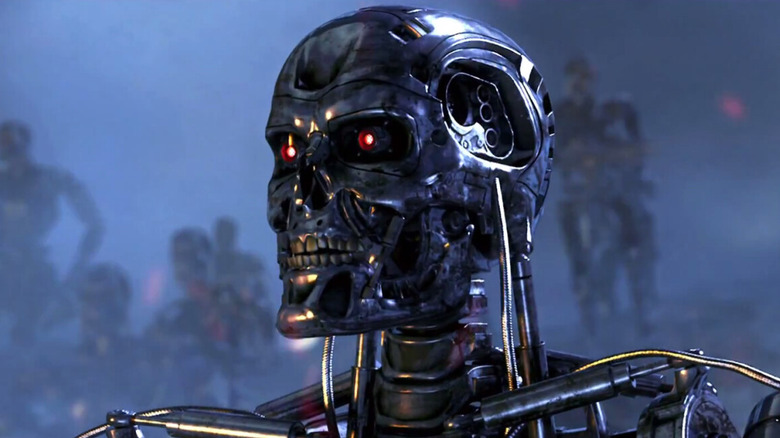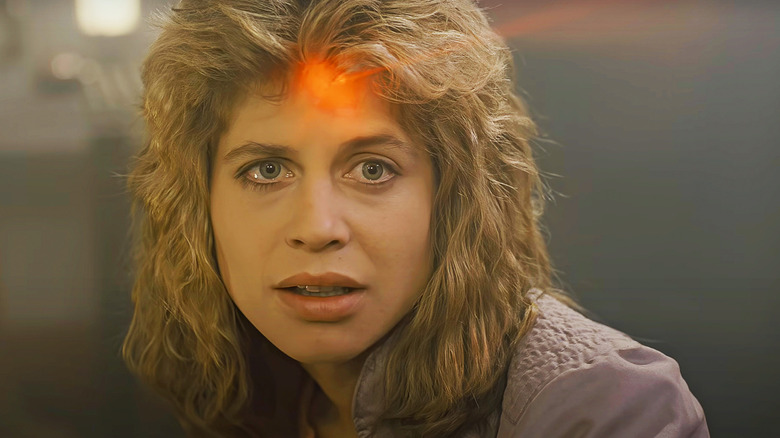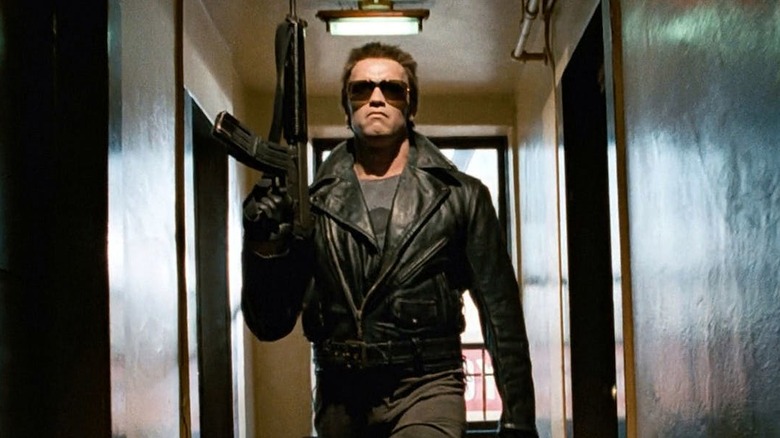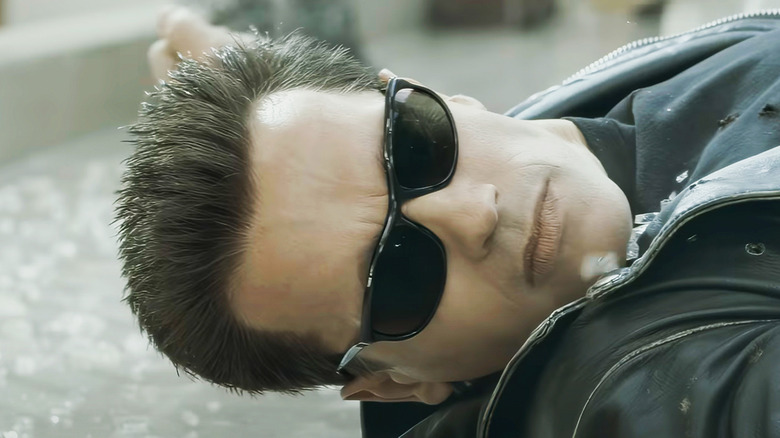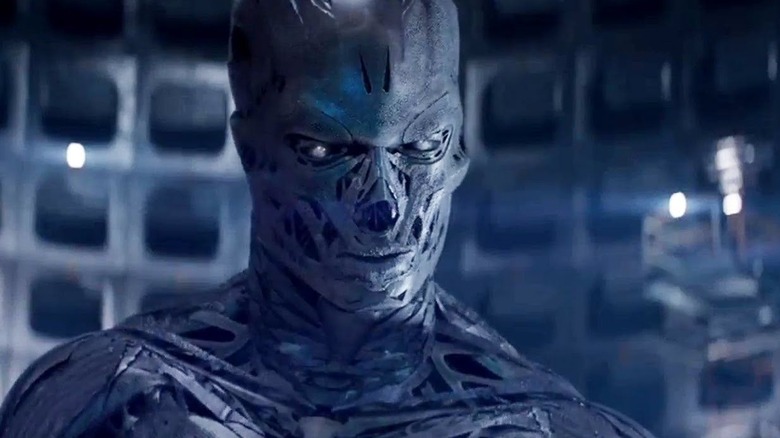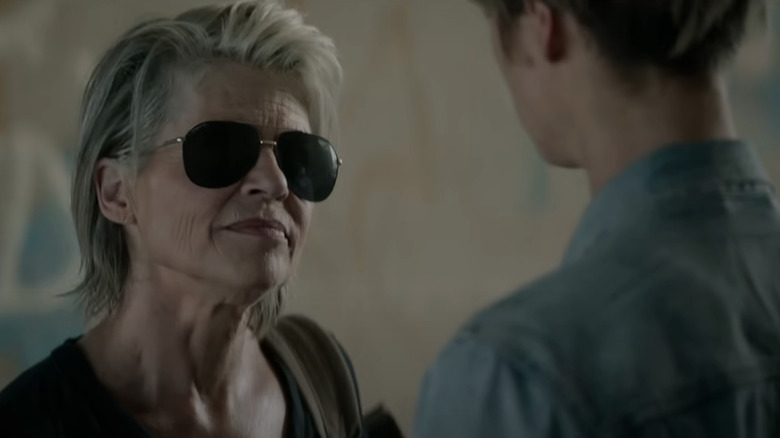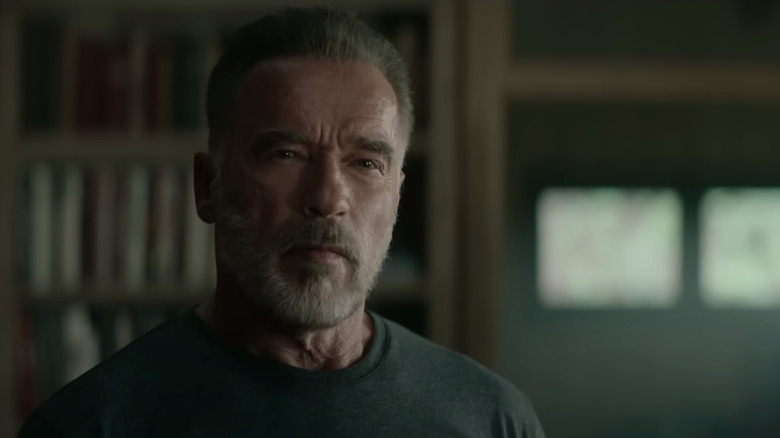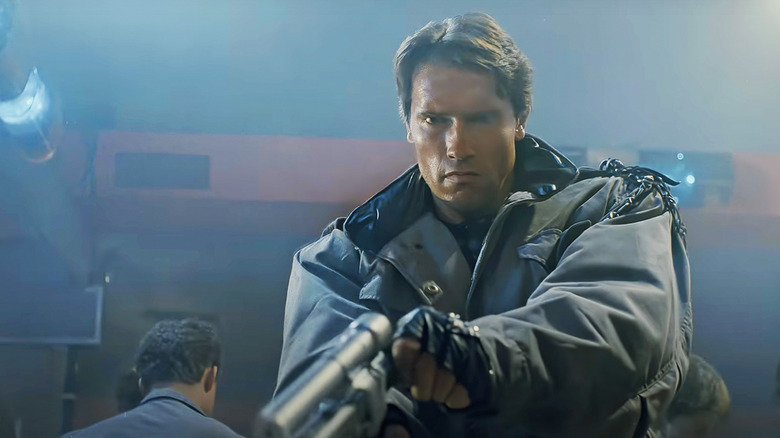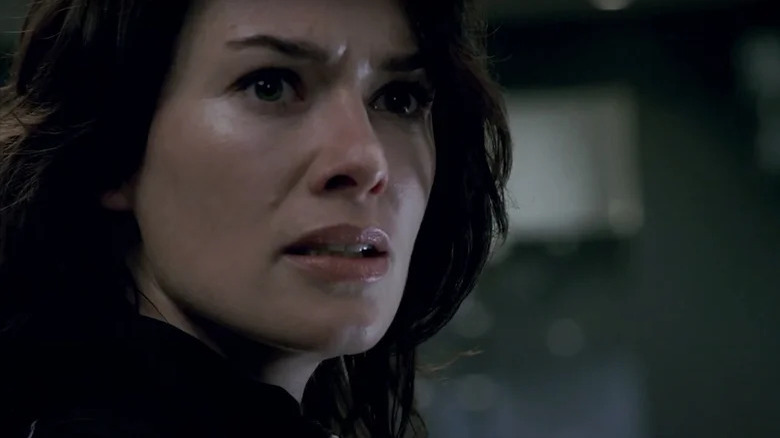From Sarah Connor To Skynet: The Terminator Timeline, Explained
"There is no future but what we make for ourselves" — the guiding principle of the Terminator franchise. Unfortunately, the real-life principle has largely amounted to, "There is no future but what Hollywood makes for the rest of us." This is one of those franchises where studios have rebooted, soft-rebooted, legacy-sequeled, and generally mangled what was once an innovative and interesting storyline into an incomprehensible mess — to the point that the saga's main star, Arnold Schwarzenegger, is now done with the franchise.
It's a sad state of affairs for this once great sci-fi story. Still, there's hope as long as creator James Cameron harbors a desire to make another Terminator movie based on A.I. For the time being, though, we're left with what has become an unnecessarily complicated Terminator timeline, leaving anyone trying to figure out the correct order to watch the Terminator movies confused. Even the first movie, 1984's "Terminator" contained enough time-travel paradoxes to confuse fans, and there have been five movies since that initial installment.
So, if you find yourself wandering the dystopian landscape wrought by Hollywood's relentless urge to wring as much life as it can out of The Terminator IP as it can, stumbling as you try to make sense of all the timeline shenanigans of the past 40 years, allow us to be your guide as we break down every Terminator timeline and how they all fit together.
There are three Terminator timelines (sort of)
Back in the early '80s, James Cameron had a neat idea to make a movie about a robot sent back in time by an omniscient AI to kill a woman who would give birth to the future leader of the human resistance. It wasn't the most straight-forward concept, but it was simple enough that it made for one hell of a cool film. 1984's "The Terminator" is essentially a slasher movie with a killer robot in the Michael Myers role. The film was a riveting sci-fi action thriller tinged with horror elements and vaguely apocalyptic overtones, and happens to be the only Arnold Schwarzenegger movie with a perfect 100% rating on Rotten Tomatoes.
"The Terminator" is also the point at which all the various franchise timelines begin — of which there are three. This is the first major point to note if you want to get your head around the Terminator chronology: Over the course of six films, there are three main timelines established. Now that we've covered that seemingly simple fact, here's the first caveat: there are actually five timelines, and arguably a lot more.
If you want to get especially technical here (and why not, since this is a whole article about timelines) there was a timeline that existed prior to the events of "The Terminator." This original chronology is essentially the way things would have been in the Terminator timeline had the events of 1984's "The Terminator" never happened. Then, there's a fifth timeline established by the TV series "Terminator: The Sarah Connor Chronicles." Confused yet? Well you don't need to be a super-intelligent A.I. to figure this out, so let's try to make sense of it all.
The Terminator movie timelines in simple terms
Before we explain what happened in each Terminator chronology, let's try to give the simplest overview possible. If we're just talking about Terminator movies, there are three main timelines in terms of how each film follows on from previous entries. Here's the breakdown:
-
"The Terminator" (1984) > "Terminator 2: Judgment Day" (1991) > "Terminator 3: Rise of the Machines" (2003) > "Terminator: Salvation" (2009)
-
"The Terminator" (1984) > "Terminator Genisys" (2015)
-
"The Terminator" (1984) > "Terminator 2" (1991) > "Terminator: Dark Fate" (2019)
As you can see, some of the later sequels disregarded the events of earlier entries in the franchise, essentially rewriting Terminator history and creating a new timeline. "Terminator Genisys" was the first film to do this, disregarding the three movies that came after the first and even rewriting the events of the 1984 original. Then, 2019's "Terminator: Dark Fate" pulled a similar trick, picking up after the events of 1991's "Terminator 2" to create yet another timeline.
So there you have it, three main chronologies laid out in simple terms. But what actually happens in these three chronologies?
The timeline from Terminator to Terminator 3
It's all well and good knowing there are three main Terminator timelines, but knowing what happens in them is the key to understanding how everything fits together (or doesn't).
In "The Terminator," an advanced AI known as Skynet sends a killer cyborg known as a T-800 model Terminator (Arnold Schwarzenegger) back in time to kill Sarah Connor (Linda Hamilton), the mother of the man that would lead the human resistance against Skynet's rise in the future, John Connor. At the end of the film, Sarah manages to kill the T-800 and ensures her child's survival.
In "Terminator 2," which happens to feature the most dangerous stunt James Cameron ever filmed, Skynet once again tries to eliminate John Connor (Edward Furlong), this time by sending an advanced T-1000 model Terminator (Robert Patrick) back to 1991 to kill John when he's just 10 years old. Thankfully, the human resistance sends a reprogrammed T-800 (Schwarzenegger) back to protect John. During the events of this film, John, Sarah, and the T-800 seemingly manage to prevent Skynet's creation by destroying the Cyberdyne systems lab developing the advanced AI, before dispatching the T-1000 in a vat of molten steel, thereby averting the day when Skynet launches the United States' nuclear weapons, aka Judgment Day.
In "Terminator 3: Rise of the Machines," we learn that Skynet's creation was merely postponed in "T2," and not prevented. The film sees a 25-year-old John Connor (Nick Stahl) once again stalked by a killer cyborg from the future, this time in the form of the T-X (Kristanna Loken). Though Arnie's T-800 once again saves John, Judgment Day finally transpires as Skynet manages to launch the nukes and usher in the post-apocalyptic future in which John will become the leader of the human resistance.
How Salvation and Genisys fit into the Terminator timeline
After "Terminator 3," things start to get more complex. Though 2009's "Terminator: Salvation" is a sequel to "T3," it was also somewhat of a soft reboot for the franchise, and was the first film in the saga to be set entirely in the post-apocalyptic future. In this story, a 2018 version of John Connor (Christian Bale) meets the mysterious Marcus Wright (Sam Worthington), who turns out to be a human augmented with cybernetic elements. Skynet sent Marcus as a way to lure John to its base where it planned to kill him, but the film ends with Marcus sacrificing himself to save John.
Though the story is somewhat removed from the events of the first three films, this fourth entry in the franchise works as a continuation of the events in "T3" and is most easily thought of as the final film in the first Terminator timeline. After "Salvation," however, things take a truly bewildering turn.
You'll usually find 2015's "Terminator Genisys" low on rankings of every Terminator movie, and part of that has to do with the overly-complicated timeline tricks it tries to pull. Honestly, a full explanation of this film's plot could take up this entire article, but in brief, the story sees Kyle Reese (Jai Courtney) once again sent from 2029 to 1984 only to discover he's in an alternate timeline in which Sarah Connor (Emilia Clarke) has joined forces with a reprogrammed T-800 Terminator (Arnold Schwarzenegger), known as "Pops." As the film goes on, we learn that, in this timeline, Skynet would eventually become Genisys, a new version of the AI that was set to once again bring about the end of the world. However, Pops, Kyle, and Sarah manage to onc destroy the nefarious AI.
The Terminator multiverse and Dark Fate
As if its central plot wasn't confusing enough, "Genisys" introduces the idea of a Terminator multiverse, with multiple timelines co-existing. The film's version of 1984 is not the same 1984 from the original "Terminator" film, signaling that while the movie is in some ways a sequel to James Cameron's inaugural entry in the franchise, it's also a complete reboot, which... yeah. Presumably the events from the original "Terminator" still occurred in an alternate timeline, but with "Genisys" we're seeing a whole new chronology play out. To this day, then, no one is really sure whether "Terminator Genisys" is a reboot or a sequel or a prequel, so just it's probably easiest to think of this ill-fated feature as a standalone Terminator entry, and the second main Terminator timeline.
While "Genisys" was a low point, however, 2019's "Terminator: Dark Fate" is the most disappointing attempt at reinvigorating this long-struggling franchise. Some, including /Film's Josh Spiegel, defended "Dark Fate" as the best Terminator movie in decades, but it remains the biggest letdown of the series as it failed to live up to the hype surrounding it. This was the movie where the great Linda Hamilton returned as Sarah Connor, where Cameron himself returned to produce, where all the needlessly confusing events of the films after "T2" were disregarded. Yet, with all this working in its favor, "Dark Fate" just couldn't right the ship, and instead introduced us to yet more timeline trickery, not to mention Arnold Schwarzenegger as a suburban dad T-800.
But let's not get too caught up in the film's failings. For our purposes, we just need to note that "Dark Fate" marks the start of the third Terminator timeline, by virtue of the fact it is a direct sequel to "Terminator 2."
Dark Fate wraps up the movie timelines
In "Dark Fate" a new liquid Terminator known as the Rev-9 (Gabriel Luna), arrives in 2020 from the future to kill Dani Ramos (Natalia Reyes), a Mexico City factory worker. Meanwhile, a cybernetically-enhanced protector, Grace (Mackenzie Davis), is sent back in time by the human resistance to protect Dani. Soon, Grace and Dani find themselves being aided in their quest to outrun the Rev-9 by Linda Hamilton's Sarah Connor, who since destroying Cyberdyne systems back in "T2" has witnessed the death of her son, John (played by a returning Edward Furlong digitally de-aged) at the hands of a T-800. This Sarah has been hunting Terminators with the help of a mysterious messenger who texts her the locations of the killer cyborgs.
As it turns out, this mysterious messenger is the very T-800 who killed John, and it has since integrated into society by renaming himself Carl, settling down with a family in Texas, and running a drape-fitting business (remember what I said about this one being the worst Terminator movie?). Soon, we learn that while Sarah, John, and the T-800 were successful in their attempt to prevent Skynet's creation, another AI would be created in the future, this one called "Legion." With John dead, Dani is revealed to be the one who leads humanity in their future fight against Legion.
In the film's climax, Grace, Dani, Sarah, and "Carl" manage to destroy the Rev-9, though Grace and Carl perish in the battle. The film ends with Dani and Sarah watching Grace as a child in the playground, with the future in which Legion tries to wipe out the human race still very much on the horizon. Thus ends the third, and final, Terminator timeline, and apparently both Arnie and Linda Hamilton's involvement with the franchise.
The Pre-Terminator timeline and its time-loop paradox
So, what's this about a pre-"Terminator" timeline? Well, in James Cameron's 1984 film, the leader of the human resistance, John Connor, sends Kyle Reese (Michael Biehn) back from a dystopian 2029 to 1984. This is because Skynet, a self-aware superintelligence, has sent a T-800 Terminator back to the same year to kill Connor's mother, Sarah (Linda Hamilton). The idea here is that Skynet wants to eliminate the possibility of John Connor ever existing, so as to rob the human rebels of their future leader. In the film, not only does Sarah survive, she and Kyle Reese conceive John Connor himself, revealing Reese to be the father of his future friend.
If you're being meticulous about the Terminator timelines, you have to imagine there was a series of events that transpired before Skynet ever sent the T-800 back in time. This timeline saw John Connor and Kyle Reese's birth, the creation of Skynet, and the nuclear war that led to the apocalyptic future in which the battle for human survival is waged. Before anyone could start sending cyborgs and protectors back through time, then, there had to be an original timeline. This is the fourth Terminator chronology.
Unfortunately, things get even more confusing. The story of 1984's "The Terminator" creates its own paradox wherein John Connor is seemingly only born because Kyle Reese is sent back in time. As such, "The Terminator" could be seen as its own, closed timeline, in which John Connor is born, grows up, sends his own father back in time to ensure his birth and thereby starts the infinite loop over again. For the sake of simplicity (and sanity), though, it's easier to think of the three aforementioned chronologies, and the "original" pre-Terminator timeline.
Where does The Sarah Connor Chronicles fit into the timeline?
Back in 2008, the Fox network debuted a new series, "Terminator: The Sarah Connor Chronicles." Created by writer and executive producer Josh Friedman, the show only lasted two seasons before being canceled, but was one of those series that managed to gain a loyal and devoted following during its brief time on-air, despite not proving quite popular enough to be recommissioned. But "The Sarah Connor Chronicles" was also noteworthy for being the first Terminator installment that simply disregarded certain entries in the franchise, setting a trend for future Terminator movies. That is to say that this series completely ignored 2003's "Terminator 3: Rise of the Machines" and picked up after the events of 1991's "Terminator 2."
Where does that leave it in the overall Terminator timeline? Well, it means that "The Sarah Connor Chronicles" essentially created its own, fifth timeline, which looks like this:
"The Terminator" (1984) > "Terminator 2: Judgment Day" (1991) > "Terminator: Sarah Connor Chronicles" (2008-2009)
Though the showrunners had a whole plot worked out for "The Sarah Connor Chronicles" going forward, Fox put an end to those plans by canceling the show, so this particular timeline ends with the final episode of the series, which aired back in April 2009. Questions about whether the show itself is "canon" are basically redundant as the Terminator timelines are so convoluted at this point, that fans can pretty much decide which version of events they want to acknowledge and which they don't.
